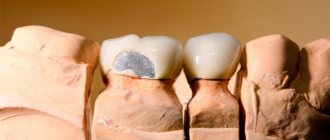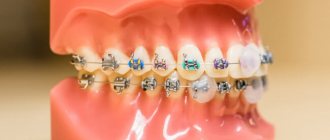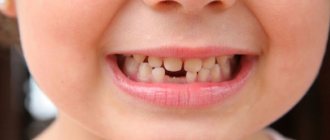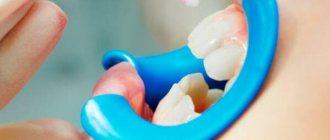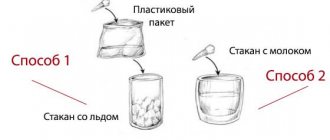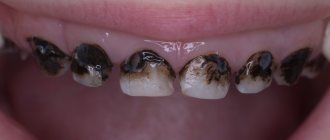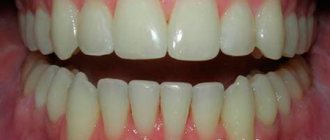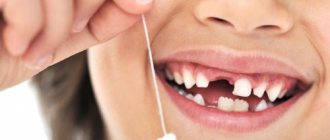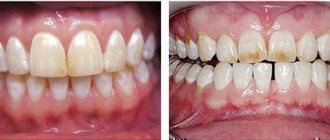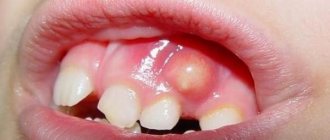Causes
The cause of dental trauma is most often the characteristics of a particular age of the child.
So, if a tooth is chipped in a child 2 years of age or younger, this may be caused by an attempt to “test” a toy, a construction piece, or another hard object. Another risk area is the period when a child is learning to feed himself using cutlery. Not yet able to distribute forces, the baby may clench his teeth too tightly, which hit the spoon or the edge of the cup, which leads to injury to one or more teeth.
When a tooth chips off in a child 5 years of age or older, it is most often due to a fall, a jump from a relatively high height, or a hit with the face on some piece of furniture, a door, etc. Eating habits may also play a role. For example, children who are accustomed to chewing candy or who do not know how to carefully bite off an apple, cracker, etc., are more likely to suffer from such dental damage.
A number of circumstances can increase the likelihood of injury:
- caries - teeth with carious cavities are more susceptible to injury;
- hypoplasia or aplasia of enamel - the protective enamel layer is fragmentarily or completely absent on the teeth, which increases the risk of injury;
- malocclusion - the distribution of the load on the teeth in such cases is uneven, and teeth that are subject to excessive pressure are injured more often;
- deformed dentition - teeth that protrude beyond the dental arch are more likely to be damaged when falling, chewing hard food, etc.
A child's front permanent tooth has chipped off
› Aesthetic dentistry
27.01.2020
A piece of a tooth broke off
Post by Nastasya » Mon Aug 29, 2005 18:58
Post by Julia and Egor » Wed Aug 31, 2005 14:05
You should have gone straight to the clinic. They would have coated your tooth with a special compound to protect the nerve. If the nerve is not damaged, then the tooth is simply extended. If damaged, the nerve is removed and the tooth is restored.
In general, it all depends on your specific situation. You should definitely go for a consultation with a dentist.
Post by Uliana » Tue Nov 22, 2005 11:53
Post by Julia and Egor » Tue Nov 22, 2005 19:41
Post by Yuliana » Thu Oct 16, 2008 14:10
Post by Tilmuna » Tue Jan 06, 2009 17:16
Kindergarten Messages: 264 On the site since 10/20/08 From: pl. Kalinina Map No. 015794 How to contact:
» Thu Jun 03, 2010 15:44
Post by Marina » Sun Jul 11, 2010 2:19
My child broke his first permanent teeth (upper teeth). Moreover, they most likely have not yet had time to fully grow, although they are already quite large. The child is 7 years old, the top two has already hatched. The inner corners of the units turned out to be broken, that is, right in the middle there was a hole in the form of such a hole.
According to the x-ray (done in Turkey under insurance), the doctor said that the hole was close to the nerves on both teeth. I have the following questions: 1. Which dental specialist should I contact? 2. What is done in such cases (extensions, crowns or something else)? 3.
How soon should teeth augmentation be done (wait until the teeth grow completely, closer to adulthood or now)? 4. What to do until the teeth are done?
5. Recommend a good doctor (clinic)!?
And in general, I am so shocked by what happened, there are simply no words. And a girl too. And the teeth were just a sight for sore eyes. It’s just some kind of nightmare, I’m so desperate.
Can anyone help with advice?
Post by Pathina » Sun Jul 11, 2010 13:08
Such chips are built up with “light” fillings. This is done by an ordinary dentist. Most likely they will advise you to wait until your teeth grow in.
At least that’s how it was for me: I broke my front teeth at the age of 8, and the dentist said that I should come back when I was 14-15 years old. But I hope something has changed in medicine in 20 years and you will get the growths sooner.
Because leaving it like that until adolescence is not very good. Believe my experience, this can develop into a serious complex
When the teeth grow, the filling may break again due to hard food - they build it up again. I redid it 3 times, once every few years. Then, at 22, she gave up and got ceramic crowns. Because the filling and the tooth differ in color, and the older the filling, the more noticeable it is. I couldn't be happier with the crowns: no problems, beautiful - convenient. If I had the money, I would have done it even earlier.
What I liked most about the Sanitas clinic: there is a machine that scans entire teeth and selects the color of the extension, exactly the same as your natural teeth. But, probably, this device is not only there.
Post by Elein » Sun Jul 11, 2010 15:58
Post by Marina » Sun Jul 11, 2010 23:15
What to do if a child’s front permanent or baby tooth breaks off?
Children by nature are very inquisitive and restless, so falls and blows are a common occurrence for them. After 5 minutes they have already forgotten about the incident and continue to play. Despite the chipped tooth, it is unlikely that they will be able to keep them from exploring the world for long. So what should parents do in a situation where the result of a fall cannot recover on its own?
Causes of chipped teeth
Frequent clients of dentists with chipped teeth are children aged 3 to 10 years. During this period, the main stage of the child’s development takes place, as well as his knowledge of the world around him. The main reasons leading to this situation are:
- Damage to a tooth due to a fall or impact.
- Since the tooth enamel in children is not yet strong enough, a possible cause of chipping may be strong clenching of the jaw.
- A chip can occur due to a poorly placed filling.
- An incorrect bite causes injury, resulting in a chip.
- Failure to contact your dentist in a timely manner may result in the filling’s warranty period expiring, which makes it likely to fall out or become damaged.
- Chipping of teeth is possible when the enamel is thinned.
- Teeth that have caries are at risk.
- Poor nutrition can cause chipping.
Lack of calcium in the body affects the thinning and weakness of tooth enamel, as a result of which it can be damaged at the slightest impact.
Parents need to monitor what the child puts in his mouth: objects or foods that are too hard can break the tooth. It is not recommended to give hot food and then cold food the next moment.
Classification and symptoms
Main symptoms of chipping:
- pain in the area of the injured tooth;
- increased sensitivity to hot and cold.
When a large piece of a tooth has broken off, anesthetic medications may not help. Despite rinsing and painkillers, the pain does not go away, and you cannot do without a doctor.
In dentistry, there is the following classification of chips:
Chip on enamel
With such damage, the child does not feel any discomfort, so they often do not contact the dentist. This is wrong, since there is a high risk of complications, in particular, damage to the dentition.
Despite the strength of tooth enamel, improper care, unbalanced nutrition and consumption of hard foods can cause harm to it, which is reflected in the thinning of the tooth enamel and the formation of cracks on it. Subsequently, sensitivity appears when eating cold and hot foods.
Dentin damage
Dentin is a mineralized tissue that follows the enamel. In terms of strength, it is an intermediate link between enamel and bones, and is responsible for the shape of the tooth.
When the tooth breaks off along with the dentin, there is open access to the nerve endings and the pulp chamber. This is fraught with the onset of infectious processes.
The presence of painful sensations is not necessary, but reactions to sour and sweet foods are common.
Exposed pulp
The main symptom of pulp exposure is severe toothache, as well as a complete or partial lack of response to anesthetics and compresses. In case of chips with exposed pulp, dentists take the following measures:
- complete removal of the pulp;
- cleaning channels and removing nerve endings;
- tooth restoration.
What to do?
When a child’s tooth is chipped, parents do not know what to do and how they can help in such a situation. Especially when the chip occurred as a result of a fall or injury, since the child experiences not only pain, but also fear.
The primary recommendation for the parent would be to calm down and not panic themselves. After this, try to calm the child, make him sit comfortably and give him a cold compress to reduce pain.
First aid
Armed with calm, you can try to provide first aid. What to do? In such cases, doctors give a whole list of advice:
- Inspect the injured area. Clean your mouth from dirt and food debris, rinse and disinfect.
- You can apply ice and take anesthetic medications to relieve swelling and reduce pain.
- In case of bleeding, place a bandage on the injury site.
- It is necessary to consult a doctor within the first two days after the incident. Otherwise, the risk of infection and complete tooth loss increases.
Complications
Children's teeth play a more significant role than it might seem at first glance. Healthy baby teeth, presented in a complete “set,” are a guarantee that the growth of permanent teeth will proceed correctly and the formation of the dentofacial apparatus will not be disrupted. For this reason, it is very important to preserve temporary teeth as long as possible and restore the injured tooth.
If a permanent tooth is damaged, especially in cases where the tooth loses its ability to perform its functions, a disturbance in the growth of the bones of the jaws and face may develop, and the dentition may be deformed.
No less dangerous are injuries to the oral mucosa that occur under the influence of the sharp edge of a damaged tooth. This disrupts local immunity and can lead to chronic stomatitis and increased susceptibility to colds.
Description of the situation
Some parents sometimes encounter the fact that their child’s baby teeth crumble, and in some cases the problem becomes almost chronic. It all starts harmlessly: the child’s corner of first one baby tooth breaks off, then another, and the parents rush to deprive him of solid food like crackers or candy, accusing the baby of being too zealous in gnawing them.
But the problem not only does not disappear, but also gets worse, while a dental examination sometimes reveals absolutely no signs of caries or mechanical damage.
A crumbling baby tooth does not cause any other negative symptoms.
The child himself does not complain of pain or inflammation of the teeth, although they continue to crumble more and more, sometimes leaving behind only small “stumps” that are sensitive to temperature changes.
This situation threatens to turn into serious problems, because there may still be a lot of time before the permanent teeth erupt, and the baby has almost nothing to chew and bite with.
Such vulnerable teeth can crumble from any slight load, and the few methods of dental treatment are not only expensive, but also effective for a fairly short time (or have a number of noticeable disadvantages).
Important! A crumbling baby tooth does not cause any other negative symptoms, so you need to be especially careful to notice and recognize the problem in time.
Treatment methods
In case of minor damage to a tooth, it is recommended to build up its lost part using restorative dental materials. In this case, the anatomical shape of the tooth is reconstructed, which returns it to its cutting or chewing functions.
If there is a deeper lesion, when the injury somehow affects the pulp, a special insulating pad is applied, and only then filling and restoration are carried out. This is done to prevent the development of pulpitis.
It is important to understand that the sooner you see a doctor, the less manipulation will be required. This is especially true for children who are afraid to visit the dentist - the longer you delay a visit to the doctor, the more changes in the tooth tissue are exposed, and the higher the likelihood that preliminary treatment of the tooth with a drill will be necessary.
Restoring a chipped tooth
When part of a tooth breaks off, it becomes sensitive and easily susceptible to infection. Such a tooth needs to be restored as soon as possible. The main treatment options for a chipped tooth:
- Remineralization. It is an auxiliary and preventive method. This technique is used when teeth have lost their strength as a result of leaching of minerals from the tissues. In such a situation, the surface is coated with special preparations containing mineral compounds. After several procedures, the protective properties of the enamel are restored due to the creation of a protective film of minerals.
Remineralization of teeth is a part of oral hygiene that allows you to correct some defects in tooth enamel that arise as a result of tooth demineralization. It helps strengthen enamel, replenish mineral deficiencies, reduce tooth sensitivity and prevent the development of caries. - Fluoridation. The procedure also involves applying medicinal preparations to the enamel. In this case, these are fluoride-containing products. The manipulation can sometimes be carried out at home, but it is preferable to entrust it to the dentist. For the procedure, as a rule, fluoride compounds are used in the form of varnishes or gels applied using a mouth guard.
- Filling and prosthetics.
Attention! If there is a large area of destruction, dental tissues must be built up using composite fillings, inlays, veneers and other restoration methods. For deep chips, tooth depulpation may be required.
Treatment at home
As a rule, if a small part of a tooth has chipped off, pain relief or other drug treatment is not required. But if you cannot see a doctor in the near future, it is important to follow the following recommendations:
- Monitor the quality of oral hygiene procedures. He should brush his teeth with toothpaste twice a day - in the morning and at night, and just with a brush - after each meal.
- Purchase an antiseptic mouthwash that is appropriate for your child's age. He should complete each teeth cleaning procedure with the use of a mouthwash.
- Carbonated drinks, sour vegetables and fruits should be excluded from the children's diet, and the amount of foods that stain teeth (beets, blueberries, black tea, chocolate, confectionery with dyes, etc.) should be limited.
- The temperature of all dishes in the children's menu should not go beyond 30-40°C; consumption of hot and cold dishes (especially in the combination “cold after hot” or vice versa) is extremely undesirable.
If a child complains of pain in an injured tooth, a non-steroidal anti-inflammatory drug intended for use in children can be given. These are Efferalgan Paracetamol, Nurofen, Panadol, etc. Be sure to read the instructions for the drug before using it.
What to pay attention to
The easiest way to determine that a child has a cracked tooth is if the crack is on the vestibular surface of the front teeth - it will be noticeable when smiling or talking.
But signs of injury are not always where they are convenient to find. Therefore, parents should pay attention to the following symptoms:
- In a small child, who is not yet able to accurately formulate his complaints, when a tooth is cracked, he may develop the habit of holding his tongue behind his cheek or behind his lips (he seems to be constantly trying something with his tongue), or he often makes chewing movements with an empty mouth.
- A darker stripe appears on the surface of the tooth (the crack itself may not be visible to the naked eye, but when it is stained with food pigments, it “appears” in the form of such a defect).
- The child complains of discomfort in the mouth when eating sweet or sour foods or brushing teeth.
The listed symptoms (in any combination) may indicate a crack in the tooth, which creates discomfort. It is important to consult a doctor as soon as possible to prevent possible consequences.

